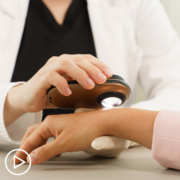Advanced Non-Melanoma Skin Cancer Test Results | Understanding YOUR Disease
Advanced Non-Melanoma Skin Cancer Test Results | Understanding YOUR Disease from Patient Empowerment Network on Vimeo.
What should advanced non-melanoma skin cancer patients know about test results? Dr. Soo Park explains the types of skin cancer tests and reviews questions you can ask your healthcare team to help better understand test results.
Dr. Soo Park is a Medical Oncologist at Moores Cancer Center at UC San Diego Health. Learn more about Dr. Park.
Related Resources:
Transcript:
Katherine:
So, once a patient has been diagnosed, what are the tests that help understand more about the patient’s individual disease?
Dr. Park:
So, it’s always important to get a biopsy, so then we can tell which type of non-melanoma skin cancer it is.
And that’s when we look at your cancer under the microscope, and a special doctor called a pathologist. And actually, they’re also really important as part of our multidisciplinary team. They look at the tumor under the microscope, and they help us decide and tell us which type of non-melanoma skin cancer it is.
But aside from that, I think imaging is really important. So, that are things like CT scans, MRI scans. Sometimes we have to also recommend a PET scan, which is another type of special scan. And these images are really to help us look deeper into the structure of your body, because I can only see so much from the outside.
And they can really help us tell how deep is the cancer; is the cancer around any critical structures? Is it anywhere else in the body? Because if we find cancer far away from where it originally occurred, that may tell us that the cancer is a later stage.
Katherine:
So, let’s just go with a scenario. Somebody comes in to you, and they have a lesion on their cheek, for instance.
Would you do a whole body MRI or a CT scan to see if that…once you’ve done a biopsy, you find that it’s cancerous. Would you do a whole body MRI, or a scan of some sort, to see if the cancer was anywhere else?
Dr. Park:
So, we typically don’t, because we know the patterns that – for instance, like you mentioned, like a skin cancer in your cheek can go to. And so, non-melanoma skin cancers on the face or anywhere in the body, they typically like to go to the lymph nodes that drain that area. And so, if you have a lesion on your face, that’s typically your neck.
And so, we’ll do a good exam of your face, your neck, but we will also get imaging of those areas. So, we typically get an imaging focused on the head and neck. If we find something abnormal there, then that may tell us we need additional imaging in the other parts of the body. But more often than not, we don’t start with a whole body scan.
Katherine:
Okay. What questions should patients ask about their test results?
Dr. Park:
So, I think patients should definitely ask, “What type of skin cancer do I have? How did it arise? Where all in my body is the skin cancer? What does my blood work look like?” And I think patients should also be aware that for many years now, we send tumor samples for something called molecular sequencing, and that just tells us different types of mutations that may be in your tumor. And that’s really important, because there are some drugs we have now that are only for patients that have specific mutations in their tumor.
And so, if you are one of those patients that has a specific mutation, that opens the door to another type of therapy for you. And, you know, that’s something that’s now recommended, actually, by a lot of cancer societies, to really send your tumor for some type of molecular sequencing, so we can level the playing field for all patients, and offer them the full range of treatments that we have.
Katherine:
Yeah. What are the common mutations?
Dr. Park:
So, for basal cell skin cancer, almost all basal cell skin cancers are driven by abnormality in a certain pathway called the hedgehog pathway. Yeah, I’m –
Katherine:
Interesting. Why?
Dr. Park:
It was named, I think, by someone. All these names are people by someone that discovered it, and they get the rights to name the pathway. But for a basal cell, it’s the hedgehog pathway. And so, in the hedgehog pathway, there are certain types of mutations specifically associated with that pathway. And one of them, among these mutations, we look for drugs that can inhibit this pathway. So, there are drugs that specifically target the hedgehog pathway.
They’re called hedgehog inhibitors, and they’re oral medications or pills that you can take every day. And those are for patients with basal cell skin cancer, because the basal cell skin cancer came about because the hedgehog pathway is not normal. But for squamous cell skin cancer, squamous cell skin cancer often has a lot of mutations. And unfortunately, they’re the type of mutations that we actually don’t have a drug for at this moment. But one unique thing about squamous cell skin cancer is that it has so many mutations.
And so, that means that it has a better chance of responding to a different type of treatment. It’s an IV treatment known as immunotherapy. And so, that’s something that’s relatively recent, I think, in the past five years now. We’ve started using immunotherapy for patients that have squamous cells skin cancer, and it’s worked remarkably well.






